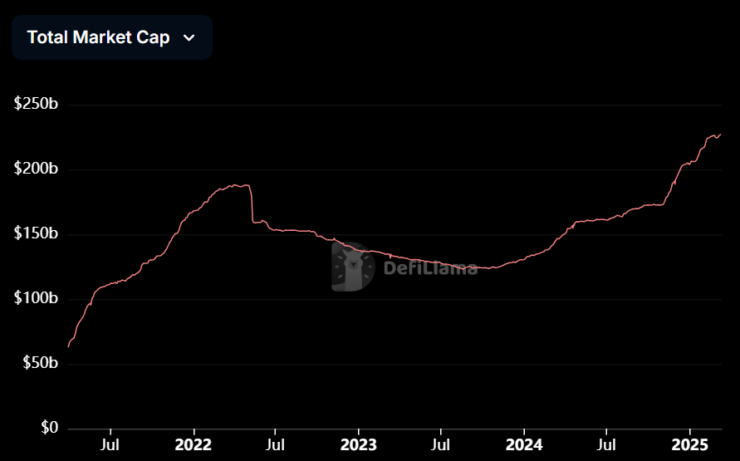The stablecoin market has reached an all-time high, with its total market capitalization soaring to $234.8 billion. This unprecedented growth signals a major shift in crypto and traditional finance, fueled by increasing adoption, institutional interest, and evolving regulations.
The two largest fiat-backed stablecoins, Tether (USDT) and USD Coin (USDC) account for most of this market cap, commanding a combined $210 billion.
- Tether (USDT) leads with $143 billion in circulation.
- USD Coin (USDC) follows with $58 billion, after an impressive 66% growth since November 2024.
Other stablecoins, including USDS, Athena USDe, sUSDS, Dai, and First Digital USD, contribute another $22 billion, bringing the top seven stablecoins’ total to $223 billion. Meanwhile, a wave of smaller stablecoins under $1 billion in market cap is rapidly expanding, with $2.45 billion worth of stablecoins minted in the past week alone, according to DeFiLlama.

USDC Gains Ground While Tether Faces Regulatory Hurdles
The stablecoin sector is witnessing a battle for dominance, particularly between USDT and USDC. While USDT remains the largest, its growth of 18% since November pales in comparison to USDC’s 66% surge.
Tether faces increasing regulatory challenges in both Europe and the United States:
- MiCA regulations in Europe have led major exchanges like Binance and Coinbase to delist USDT, affecting its regional dominance.
- The U.S. Senate’s proposed GENIUS Act could impose stricter rules on non-U.S.-based dollar-pegged stablecoins, complicating Tether’s position in the American market.
Stablecoins are evolving beyond their traditional roles in crypto trading and DeFi lending. Major financial players are beginning to integrate stablecoin technology into mainstream payment systems:
- PayPal’s PYUSD, the 10th-largest stablecoin with a $665 million market cap, is rolling out for B2B payments.
- Fintech giants like Revolut and Stripe are integrating stablecoins into their payment processing systems.
- Paxos, a leading stablecoin issuer, has partnered with Standard Chartered to expand its offerings.
The Trump Administration’s Crypto Stance
The U.S. government is taking a strategic interest in stablecoins. During the White House Crypto Summit on March 7, U.S. Treasury Secretary Scott Bessant reinforced the administration’s view that stablecoins are essential for maintaining the U.S. dollar’s dominance.
“We are going to keep the U.S. dollar the dominant reserve currency in the world, and we will use stablecoins to do that,” Bessant stated.
This signals that stablecoins could play a central role in global trade and cross-border transactions at the institutional and retail levels.
What’s Next for Stablecoins?
The rise of stablecoins is no longer just a crypto phenomenon—it’s a financial evolution. Institutional players are driving adoption, governments are shaping regulations, and the technology is bridging the gap between traditional and digital finance.
However, the future remains uncertain. Will regulation level the playing field for new stablecoin issuers, or will it further cement the dominance of a few key players?
As Rachel Lin, CEO of SynFutures, noted:
“The Trump administration’s pro-crypto stance lends regulatory credibility, amplifying this trend, but the real question is what comes next. Will regulation create a level playing field for innovation, or will it just reinforce the dominance of a few big players?”
One thing is clear: the stablecoin market is just getting started.





